Manage Schemas for Topics in Control Center (Legacy)
Use the Schema Registry feature in Control Center (Legacy) to manage Confluent Platform topic schemas.
You can:
create, edit, and view schemas
compare schema versions
download schemas
The Schema Registry performs validations and compatibility checks on schemas.
Tip
Review the step-by-step tutorial for using Schema Registry.
For comprehensive information on Schema Registry, see the Schema Registry documentation.
The Schema Registry feature in Control Center (Legacy) is enabled by default. Disabling the feature disables both viewing and editing of schemas.
Create a topic schema in Control Center (Legacy)
Create key and value schemas. Value schemas are typically created more frequently than a key schema.
Best practices:
Provide default values for fields to facilitate backward-compatibility if pertinent to your schema.
Document at least the more obscure fields for human-readability of a schema.
Create a topic value schema
Select a cluster.
Click Topics on the menu. The Topics Overview for Control Center (Legacy) appears.
Select a topic.

The topic overview page is displayed.
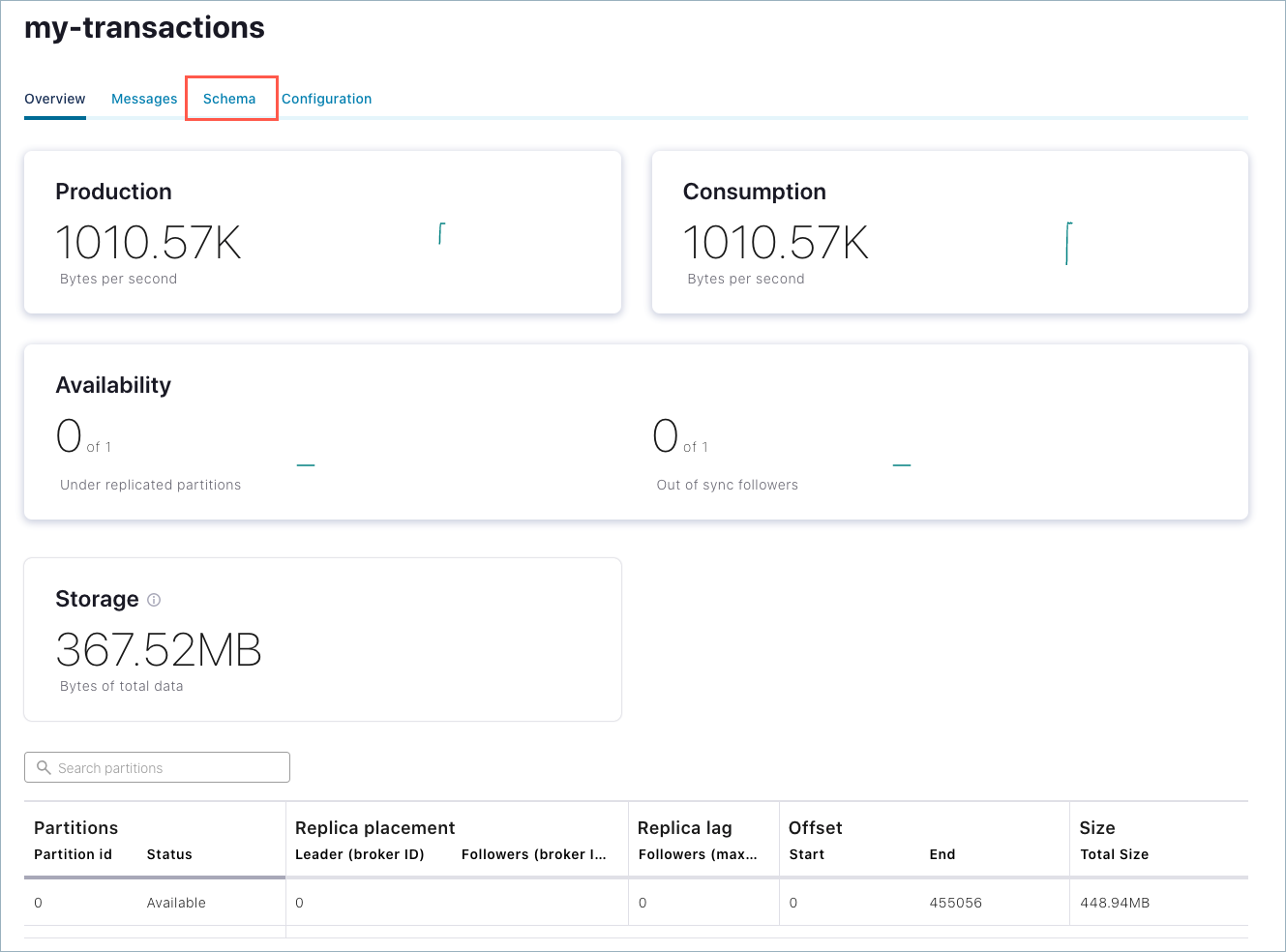
Click the Schema tab.
You are prompted to set a message value schema.

Click Set a schema. The Schema editor appears pre-populated with the basic structure of an Avro schema to use as a starting point, if desired.
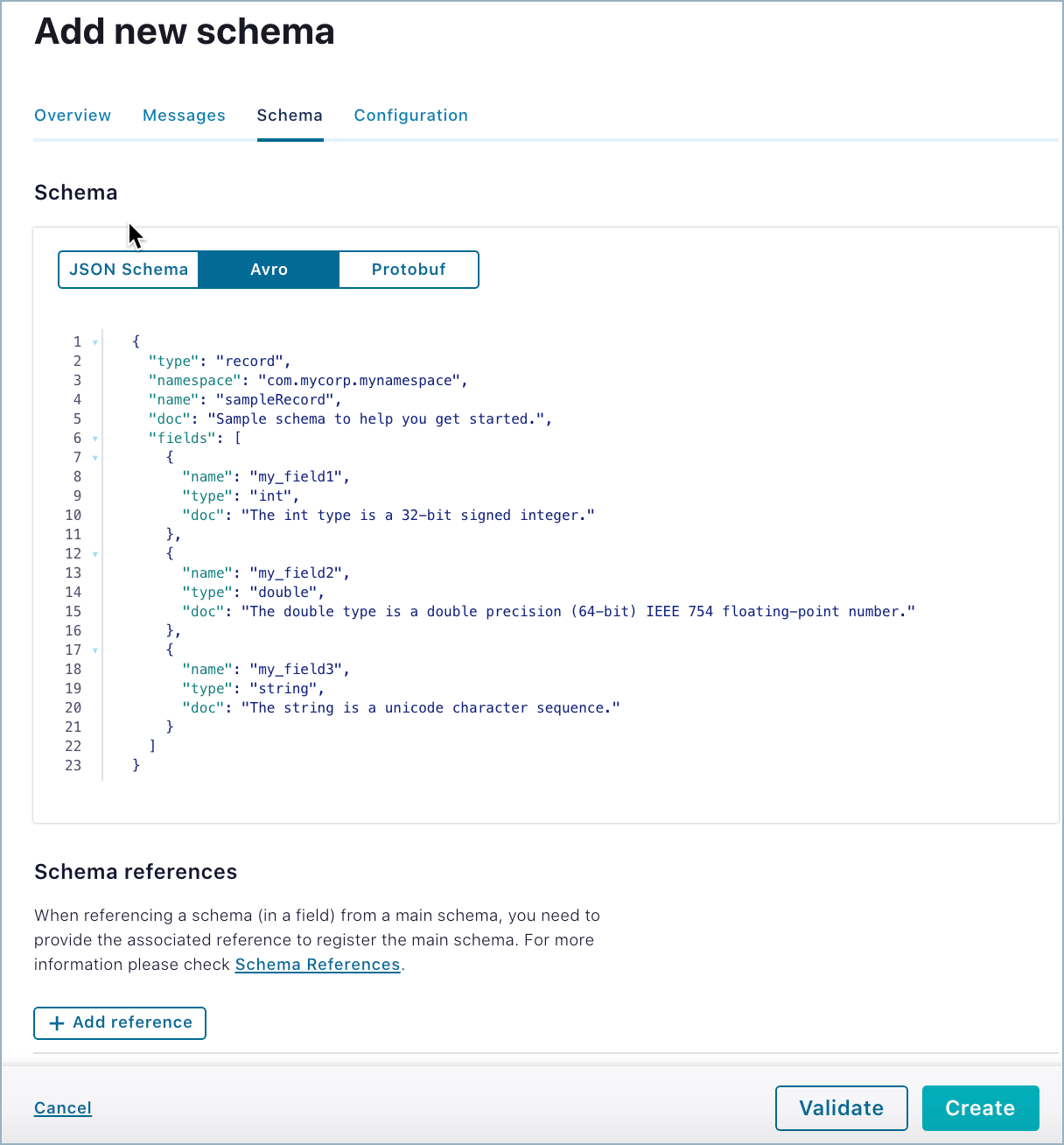
Select a schema format type:
Avro
JSON
Protobuf
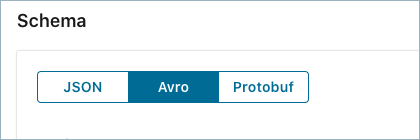
Choose Avro if you want to try out the code examples provided in the next steps.
Tip
To learn more about each of the schema types, see Supported formats.
Enter the schema in the editor:
name: Enter a name for the schema if you do not want to accept the default, which is determined by the subject name strategy. The default isschema_type_topic_name. Required.type: Eitherrecord,enum,union,array,map, orfixed. (The typerecordis specified at the schema’s top level and can include multiple fields of different data types.) Required.namespace: Fully-qualified name to prevent schema naming conflicts. String that qualifies the schemaname. Optional but recommended.fields: JSON array listing one or more fields for a record. Required.Each field can have the following attributes:
name: Name of the field. Required.type: Data type for the field. Required.doc: Field metadata. Optional but recommended.default: Default value for a field. Optional but recommended.order: Sorting order for a field. Valid values are ascending, descending, or ignore. Default: Ascending. Optional.aliases: Alternative names for a field. Optional.
Copy and paste the following example schema.
{ "type": "record", "namespace": "my.examples", "name": "Payment", "fields": [ { "name": "id", "type": "string" }, { "name": "amount", "type": "double" } ] }
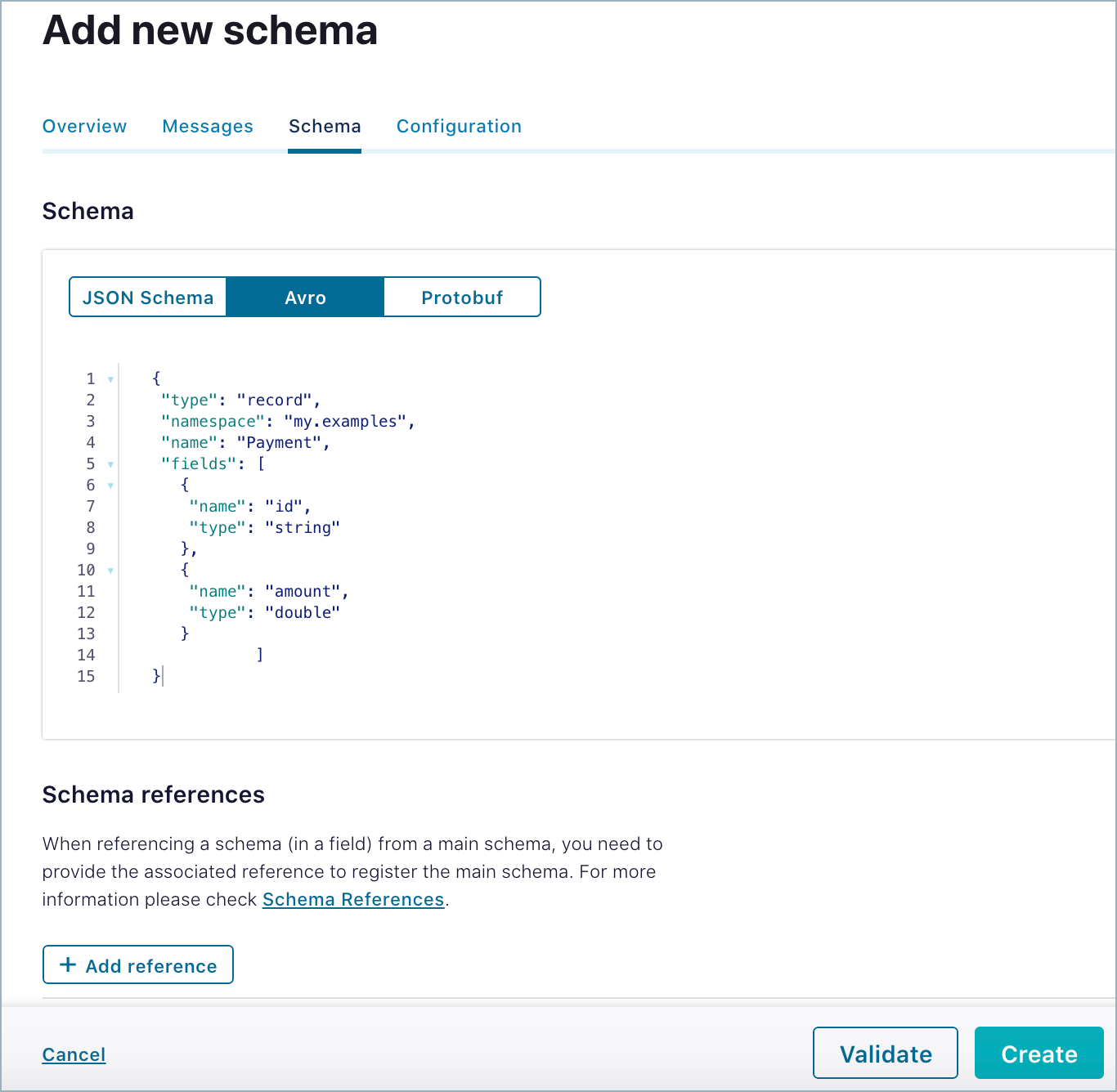
In edit mode, you have options to:
Validate the schema for syntax and structure before you create it.
Add schema references with a guided wizard.
Click Create.
If the entered schema is valid, the Schema updated message is briefly displayed in the banner area.
If the entered schema is not valid, an Input schema is an invalid Avro schema error is displayed in the banner area.
If applicable, repeat the procedure as appropriate for the topic key schema.
Working with schema references
You can add a reference to another schema, using the wizard to help locate available schemas and versions.
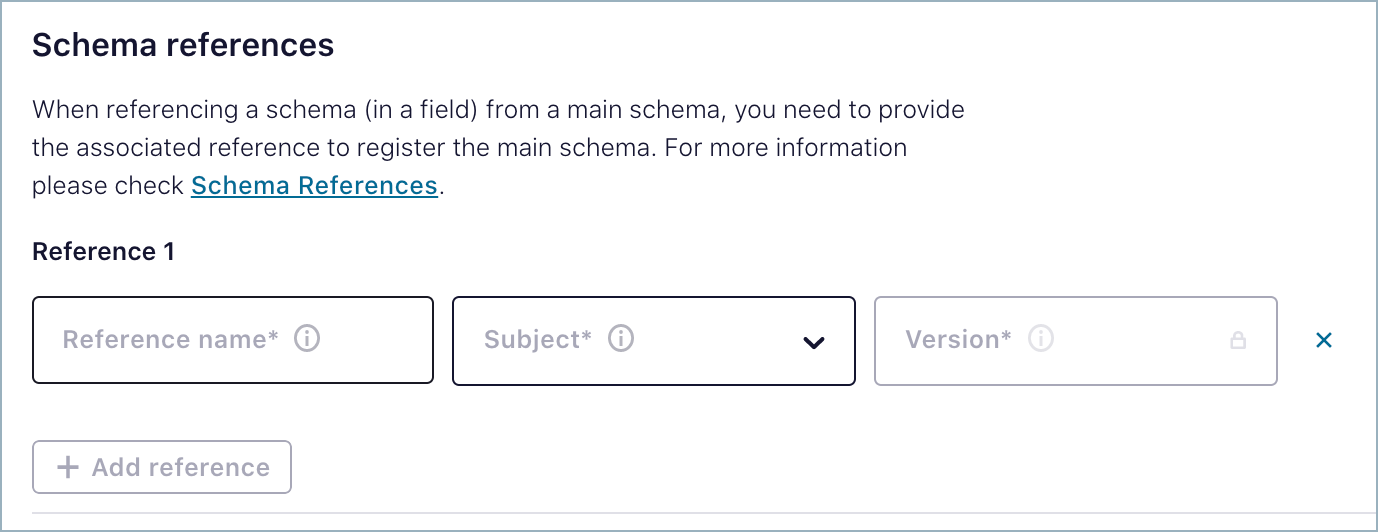
The Reference name you provide must match the target schema, based on guidelines for the schema format you are using:
In JSON Schema, the name is the value on the
$reffield of the referenced schemaIn Avro, the name is the value on the
typefield of the referenced schemaIn Protobuf, the name is the value on the
Importstatement referenced schema
First, locate the schema you want to reference, and get the reference name for it.
Add a schema reference to the current schema in the editor
Click Add reference.
Provide a Reference name per the rules described above.
Select the schema fro the Subject list.
Select the Version of the schema you want to use.
Click Validate to check if the reference will pass.
Click Save to save the reference.
For example, to reference the schema for the my-transactions topic (my-transactions-value) from the widget schema, you can configure a reference to type, record as shown.
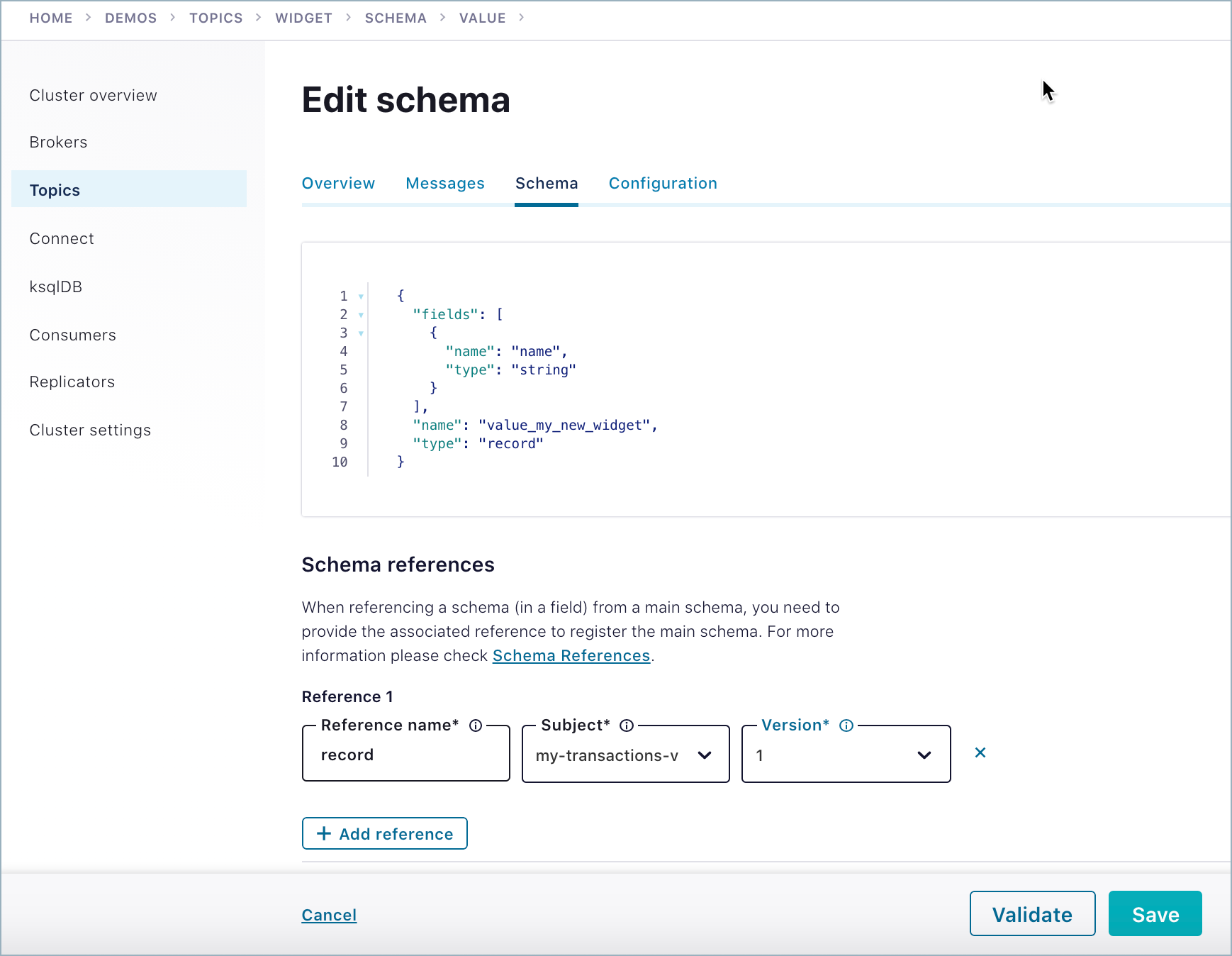
To learn more, see Schema references in the schema formats developer documentation.
View, edit, or delete schema references for a topic
Existing schema references show up on editable versions of the schema where they are configured.
Navigate to a topic; for example, the
widget-valueschema associated with thewidgettopic in the previous example.Click into the editor as if to edit the schema.
If there are references to other Schemas configured in this schema, they will display in the Schema references list below the editor.
You can also add more references to this schema, modify existing, or delete references from this view.
Create a topic key schema
Click the Key option. You are prompted to set a message key schema.

Click Set a schema.
Choose Avro format and/or delete the sample formatting and simply paste in a string UUID.
Enter the schema into the editor and click Save.
Copy and paste the following example schema, and save it.
{ "namespace": "io.confluent.examples.clients.basicavro", "name": "key_my_transactions", "type": "string" }

In edit mode, you have options to:
Validate the schema for syntax and structure before you create it.
Add schema references with a guided wizard.
Best Practices and Pitfalls for Key Values
Kafka messages are key-value pairs. Message keys and message values can be serialized independently. For example, the value may be using an Avro record, while the key may be a primitive (string, integer, and so forth). Typically message keys, if used, are primitives. How you set the key is up to you and the requirements of your implementation.
As a best practice, keep key value schema complexity to a minimum. Use either a simple, non-serialized data type such as a string UUID or long ID, or an Avro record that does not use maps or arrays as fields, as shown in the example below. Do not use Protobuf messages and JSON objects for key values. Avro does not guarantee deterministic serialization for maps or arrays, and Protobuf and JSON schema formats do not guarantee deterministic serialization for any object. Using these formats for key values will break topic partitioning. If you do decide to use a complex format for a key value schema, set auto.register.schemas=false to prevent registration of new valid and compatible schemas that, because of the complex key value format, will break your partitioning. To learn more, see Auto Schema Registration in the On-Premises Schema Registry Tutorial, and Partitioning gotchas in the Confluent Community Forum.
For detailed examples of key and value schemas, see the discussion under Formats, Serializers, and Deserializers in the Schema Registry documentation.
Viewing a schema in Control Center (Legacy)
View the schema details for a specific topic.
Select a cluster from the navigation bar.
Click the Topics menu. The Topics Overview for Control Center (Legacy) appears.
Select a topic.

The topic overview page appears.
Click the Schema tab.
The Value schema is displayed by default.
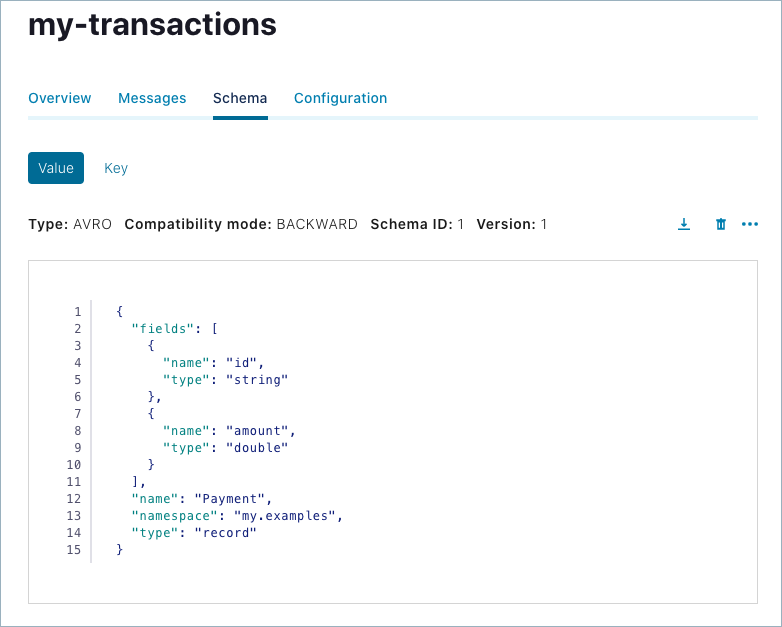
Tip
The Control Center (Legacy) schema display may re-order the placement of meta information about the schema. Comparing this view with the example provided in the previous section, note that schema name, namespace, and record type are shown below the field definitions. This is an artifact of the display in Control Center (Legacy); the schema definition is the same.
Click the Key tab to view the key schema if present.
Editing a schema in Control Center (Legacy)
Edit an existing schema for a topic.
Select a cluster from the navigation bar.
Click the Topics menu. The Topics Overview for Control Center (Legacy) appears.
Select a topic.
Click the Schema tab.
Select the Value or Key tab for the schema.
Click anywhere in the schema to enable edit mode and make changes in the schema editor.
For example, if you are following along with the example:
Select the topic
my-transactions, click Schema, and select the Value tab.Edit the schema by copy-pasting the following definition for a new
regionfield, after theidandamountfields. Precede your new definition with a comma, per the syntax.{ "name": "region", "type": "string", "default": "" }
Note that the new
regionfield includes a default value, which makes it backward compatible. By plugging in the default value, consumers can use the new schema to read data submitted by producers that use the older schema (without theregionfield).Click Save.
If the schema update is valid and compatible with its prior versions (assuming a backward-compatible mode), the schema is updated and the version count is incremented. You can compare the different versions of a schema.
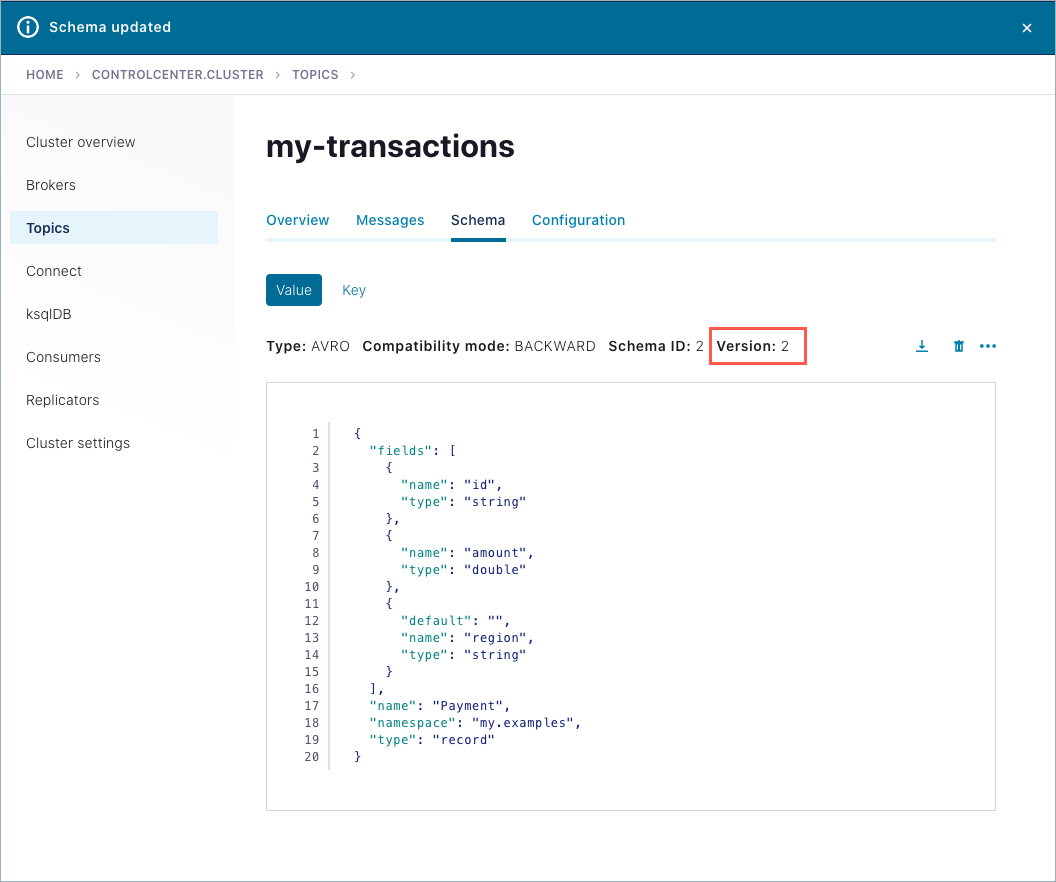
If the schema update is invalid or incompatible with an earlier schema version, an error is displayed.
The example below shows the addition of another new field,
country, with no default provided for backward compatibility.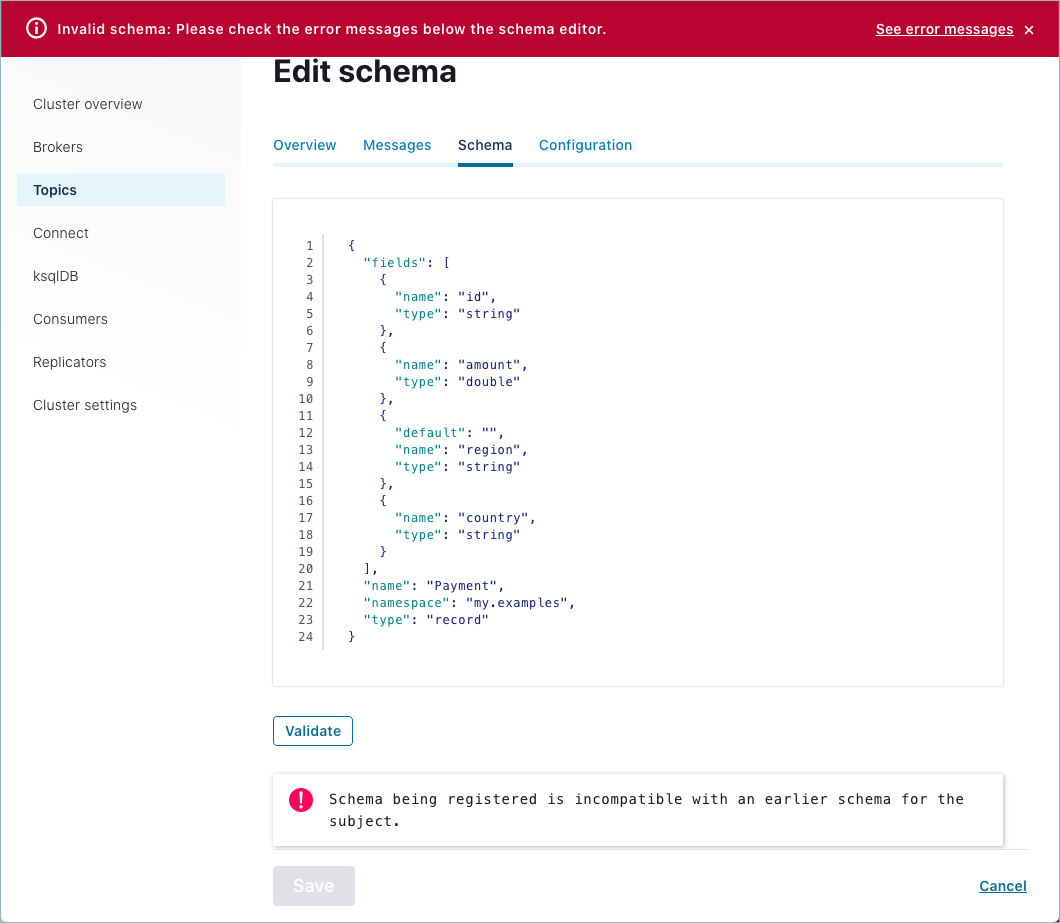
Tip
You can also add schema references as a part of editing a schema, as described in Working with schema references.
Comparing schema versions in Control Center (Legacy)
Compare versions of a schema to view its evolutionary differences.
Select a cluster from the navigation bar.
Click the Topics menu. The Topics Overview for Control Center (Legacy) appears.
Select a topic.
Click the Schema tab.
Select the Key or Value tab for the schema.
Select Version history from the inline menu.
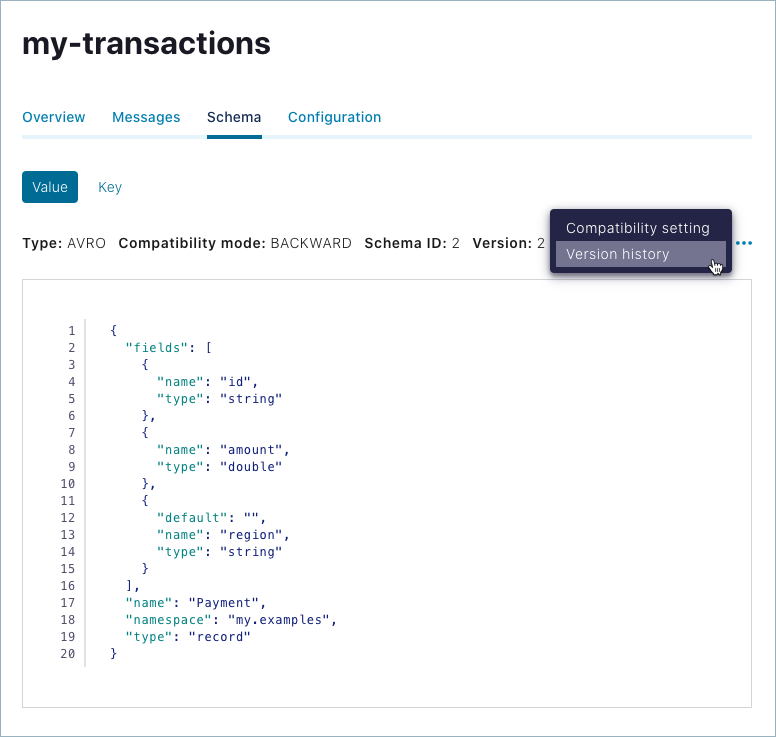
The current version number of the schema is indicated on the version menu.

Select the Turn on version diff check box.
Select the versions to compare from each version menu. The differences are highlighted for comparison.
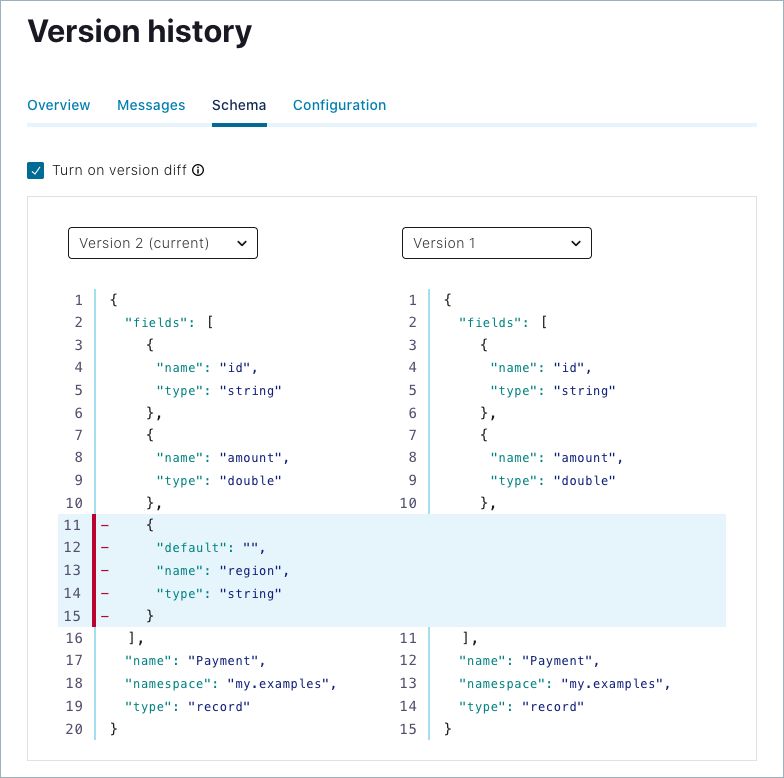
Changing the compatibility mode of a schema in Control Center (Legacy)
The default compatibility mode is Backward. The mode can be changed for the schema of any topic if necessary.
Caution
If you change the compatibility mode of an existing schema already in production use, be aware of any possible breaking changes to your applications.
Select a cluster from the navigation bar.
Click the Topics menu. The Topics Overview for Control Center (Legacy) appears.
Select a topic.
Click the Schema tab.
Select the Key or Value tab for the schema.
Select Compatibility setting from the inline menu.

The Compatibility settings are displayed.
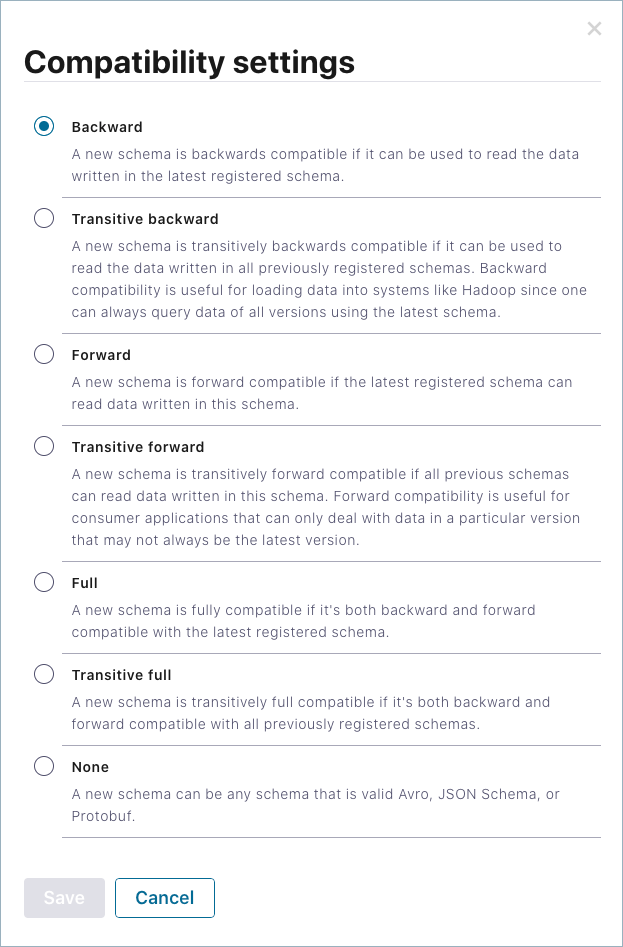
Select a mode option:
Descriptions indicate the compatibility behavior for each option. For more information, including the changes allowed for each option, see Schema Evolution and Compatibility for Schema Registry on Confluent Platform.
Click Save.
Downloading a schema from Control Center (Legacy)
Select a cluster from the navigation bar.
Click the Topics menu. The Topics Overview for Control Center (Legacy) appears.
Select a topic.
Click the Schema tab.
Select the Key or Value tab for the schema.
Click Download. A schema JSON file for the topic is downloaded into your Downloads directory.
Example filename:
schema-transactions-v1-Ry_XaOGvTxiZVZ5hbBhWRA.jsonExample contents:
{"subject":"transactions-value","version":1,"id":2,"schema":"{\"type\":\"record\",\"name\":\"Payment\", \"namespace\":\"io.confluent.examples.clients.basicavro\", \"fields\":[{\"name\":\"id\",\"type\":\"string\"},{\"name\":\"amount\",\"type\":\"double\"}, {\"name\":\"region\",\"type\":\"string\"}]}"}
This is the first version of the schema, and it has an
idof 2. The schema is escaped JSON. A backslash precedes double-quotes.
Troubleshoot error “Schema Registry is not set up”
If you get an error message on Control Center (Legacy) when you try to access a topic schema (”Schema Registry is not set up”), first make sure that Schema Registry is running. Then verify that the Schema Registry listeners configuration matches the Control Center (Legacy) confluent.controlcenter.schema.registry.url configuration. Also check the HTTPS configuration parameters.
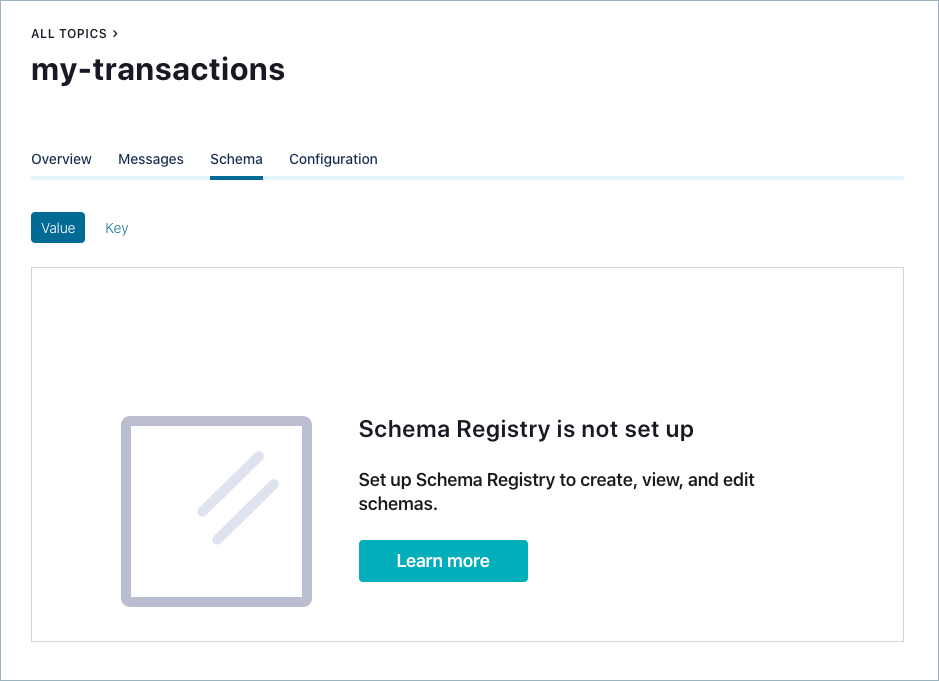
For more information, see A schema for message values has not been set for this topic, and start-up procedures for Quick Start for Confluent Platform, or Install Confluent Platform On-Premises, depending on which one of these you are using to run Confluent Platform.
Enabling and disabling Schema Registry in Control Center (Legacy)
The feature that allows working with schemas in Control Center (Legacy) is enabled by default. The feature can be disabled if an organization does not want any users to access the feature. After disabling the feature, the Topics Schema menu and the Schema tab are no longer visible in the Control Center (Legacy) UI. The ability to view and edit schemas is disabled.
To disable the edit schema feature in Control Center (Legacy):
Set the
confluent.controlcenter.schema.registry.enableoption in yourcontrol-center.propertiesfile tofalse.confluent.controlcenter.schema.registry.enable=false
Note
Make the change in the appropriate Control Center (Legacy) properties file or files configured for your environments, including
control-center-dev.propertiesorcontrol-center-production.properties. The properties files are located in/path-to-confluent/etc/confluent-control-center/.Restart Control Center (Legacy) and pass in the properties file for the configuration to take effect:
./bin/control-center-stop ./bin/control-center-start ../etc/confluent-control-center/control-center.propertiesTip
If you are using a Confluent Platform development environment with a confluent local, stop and start as follows:
|confluent_local_stop_control_center| |confluent_local_stop_control_center| ../etc/confluent-control-center/control-center-dev.properties
To enable the feature again, set the option back to true and restart Control Center (Legacy) with the updated properties file.
Enabling Multi-Cluster Schema Registry
Starting with version 5.4.1, Confluent Platform supports the ability to run multiple schema registries and associate a unique Schema Registry to each Kafka cluster in multi- cluster environments.
The ability to scale up schema registries in conjunction with Kafka clusters is useful for evolving businesses; and particularly supports data governance, organization, and management across departments in large enterprises.
When multi-cluster Schema Registry is configured and running, you can create and manage schemas per topics in Control Center (Legacy) as usual.
Configuration Properties and Files
Multiple Schema Registry clusters may be specified with confluent.controlcenter.schema.registry.{name}.url in the appropriate Control Center (Legacy) properties file. To use a Schema Registry cluster identified in this way, add or verify the following broker and Control Center (Legacy) configurations.
A new endpoint /v1/metadata/schemaRegistryUrls has been exposed by Kafka to return the confluent.schema.registry.url field from the Kafka broker configurations. Control Center (Legacy) uses this field to look up the registries from Kafka broker configurations. To use this, you must configure unique listener endpoints for each cluster:
In the broker
server.propertiesfiles (unique for each Kafka cluster), specify the REST endpoint with theconfluent.http.server.listenersfield, which defaults tohttp://0.0.0.0:8090.In the appropriate Control Center (Legacy) properties file, use
confluent.controlcenter.streams.cprest.urlto define the REST endpoint forcontrolcenter.cluster.For additional clusters, define REST endpoints using
confluent.controlcenter.kafka.{name}.cprest.url. This should be consistent with the Kafka cluster name used for other Kafka Control Center (Legacy) configurations; for example,confluent.controlcenter.kafka.{name}.bootstrap.servers.
A minimal viable configuration touches the following files, and includes settings for these properties (example names and ports are given):
Control Center (Legacy) properties file
The Control Center (Legacy) Properties File file includes:
confluent.controlcenter.schema.registry.url=http://localhost:8081confluent.controlcenter.schema.registry.sr-1.url=http://localhost:8082confluent.controlcenter.streams.cprest.url=http://localhost:8090confluent.controlcenter.kafka.AK1.cprest.url=http://localhost:8091
See Control Center configuration reference for a full description of confluent.controlcenter.schema.registry.url.
Broker configuration file for the Control Center (Legacy) cluster
The Kafka broker configuration file for controlcenter.cluster, such as server0.properties, includes:
confluent.http.server.listeners=http://localhost:8090confluent.schema.registry.url=http://localhost:8081
Broker configuration file for the Kafka cluster
The Kafka broker configuration file for AK1, server1.properties) includes:
confluent.http.server.listeners=http://localhost:8091confluent.schema.registry.url=http://localhost:8082
With these configurations, editing the schema through the Control Center (Legacy) UI will connect to http://localhost:8081 for controlcenter.cluster and http://localhost:8082 for AK1.
Defaults and Fallback
If confluent.schema.registry.url fields are not specified for any brokers, the confluent.controlcenter.schema.registry.url Schema Registry URL is applied. For example, if the Schema Registry URL was not provided for AK1, AK1’s associated Schema Registry cluster would also be specified at http://localhost:8081. If confluent.controlcenter.schema.registry.url is not explicitly specified in the Control Center (Legacy) properties file, it defaults to http://localhost:8081.
Example
Following is a detailed example of a functional multi-cluster Schema Registry setup with two Kafka clusters connected to Control Center (Legacy), one the controlcenter.cluster, and the other named AK1, each with one broker.
The table below shows files and configurations in each for the two cluster example. These are not complete properties files, but rather excerpts from each file that define multi-cluster Schema Registry specifics, port numbers, and configurations that are important to the example setup or generally not found in default properties files.
To run the example, copy default Apache ZooKeeper™, Kafka (server.properties), Schema Registry, and Control Center (Legacy) control-center-dev.properties configuration files to new files per the example filenames below, add/modify properties as shown, and run the components as described in Run the Example.
Key Configurations
| File | Properties |
| zookeeper0.properties |
|
| zookeeper1.properties |
|
| server0.properties |
|
| server1.properties |
|
| schema-registry0.properties |
|
| schema-registry1.properties |
|
| control-center-multi-sr.properties |
cpcrest.url, confluent.controlcenter.kafka.AK1.cprest.url, and confluent.controlcenter.schema.registry.SR-AK1.url are new properties, specific to multi-cluster Schema Registry. |
Tip
The values for kafkastore.topic and schema.registry.group.id must be unique for each Schema Registry properties file because in this example the two registries are colocated on localhost. If the Schema Registry clusters were on different hosts, you would not need to make these changes.
Run the Example
To run the example:
Start the ZooKeepers.
Start the Kafka brokers
Start the Schema Registry clusters.
Start Confluent Control Center (Legacy).
The following example start commands assume the properties files are in the <path-to-confluent>/etc/ directories shown below, and that you are running the commands from <path-to-confluent>.
Start ZooKeepers
./bin/zookeeper-server-start etc/kafka/zookeeper0.properties
./bin/zookeeper-server-start etc/kafka/zookeeper1.properties
Start the Kafka brokers
./bin/kafka-server-start etc/kafka/server0.properties
./bin/kafka-server-start etc/kafka/server1.properties
Start Schema Registry clusters
./bin/schema-registry-start etc/schema-registry/schema-registry0.properties
./bin/schema-registry-start etc/schema-registry/schema-registry1.properties
Start Control Center
./bin/control-center-start etc/confluent-control-center/control-center-multi-sr.properties
Manage Schemas for Both Clusters on Control Center (Legacy)
When the example clusters are running and Control Center (Legacy) finishes initialization, open Control Center (Legacy) in your web browser. (Control Center (Legacy) runs at
http://localhost:9021/by default, as described in Configure and access Control Center (Legacy).)Select a cluster from the navigation bar, click the Topics menu, and explore the schema management options for one or both clusters, starting with Create a topic schema in Control Center (Legacy).
Security
Any other configurations used to set up a Schema Registry client with Control Center (Legacy) can be configured for an additional Schema Registry cluster by simply appending the Schema Registry cluster’s name to the confluent.controlcenter.schema.registry prefix.
For example, for HTTP Basic authentication with multi-cluster Schema Registry, specify the following in the Confluent Control Center (Legacy) configuration file:
Use
confluent.controlcenter.schema.registry.basic.auth.credentials.sourceandconfluent.controlcenter.schema.registry.basic.auth.user.infoto define authentication for theconfluent.controlcenter.schema.registry.urlcluster.Use
confluent.controlcenter.schema.registry.{name}.basic.auth.credentials.sourceandconfluent.controlcenter.schema.registry.{name}.basic.auth.user.infofor additional Schema Registry clusters (associated with the URL fields by{name}).
Some Schema Registry client configurations also include a schema.registry prefix. For SSL security settings, specify the following in the Confluent Control Center (Legacy) configuration file:
Use
confluent.controlcenter.schema.registry.schema.registry.ssl.truststore.locationandconfluent.controlcenter.schema.registry.schema.registry.ssl.truststore.passwordfor theconfluent.controlcenter.schema.registry.urlcluster.Use
confluent.controlcenter.schema.registry.{name}.schema.registry.ssl.truststore.locationandconfluent.controlcenter.schema.registry.{name}.schema.registry.ssl.truststore.passwordfor additional Schema Registry clusters (associated with the URL fields by{name}).
To learn more, see Schema Registry authentication properties in the Control Center (Legacy) Configuration Reference under Security for Confluent Platform components and the section on Schema Registry in HTTP Basic authentication. To learn more, see How to configure clients to Schema Registry in the Schema Registry Security Overview.
Errors and Troubleshooting
If the brokers for the cluster have matching Schema Registry URLs, but these URLs were not defined in the Control Center (Legacy) properties file, an error message is displayed on the cluster overview page.

Version Compatibility
The confluent.controlcenter.schema.registry.url configuration in the Control Center (Legacy) properties file acts as a default if a cluster’s broker configurations do not contain confluent.schema.registry.urlfields. Multiple Schema Registry clusters may be specified with confluent.controlcenter.schema.registry.{name}.url fields.
Multi-cluster Schema Registry cannot be used with Kafka versions prior to Kafka 2.4.x, the version current with Confluent Platform 5.4.0. However, using a single cluster Schema Registry setup will work with earlier Kafka versions. To learn more, see Confluent Platform and Apache Kafka Compatibility.
Suggested Reading
See On-Premises Schema Registry Tutorial for hands-on examples of developing schemas, mapping to topics, and sending messages.
See Schema Registry for Confluent Platform for an overview of Schema Registry and schema management.
A schema for message values has not been set for this topic in Troubleshooting Control Center (Legacy)